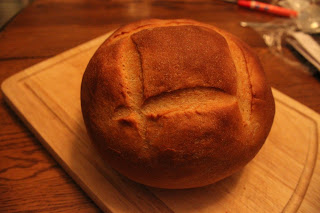
I had my reservations following the shaping stage, because the bread hadn't risen a lot during proofing, and an elastic, almost pasta-like feel when I was rolling out the strands for braiding. However, it doubled very quickly after shaping, and then had incredible oven spring. You can actually see this in the first picture, where there is a lack of any seeds in between the braids.
The Challah turned out wonderful. Very soft, sweet creamy bread. But of course, my Challah experience is very limited. To really see if I passed the test, we brought over one of the loaves to our neighbour, Mya, who just happens to be Jewish. The first thing she remarked after I told her I brought her Challah, was "on Friday night, how appropriate!" Watching her, her husband and her two sons, aged one and three, dig into the Challah right at the door with their bare hands made me smile! And it was a huge it -- "this is EXACTLY like Challah i'm used to!!," Mya exclaimed. I left with the heart-warming thought that "breaking bread" remains a fundamental expression of our common humanity.

















